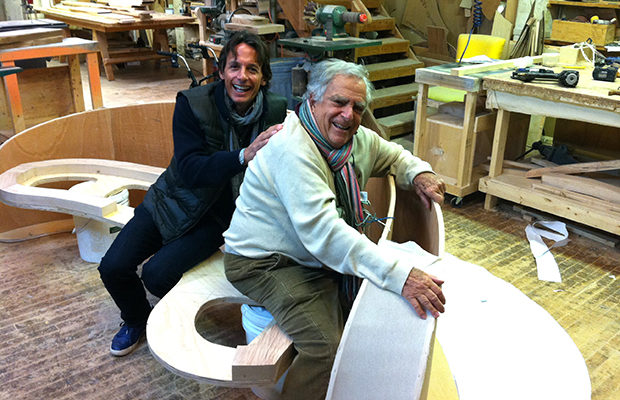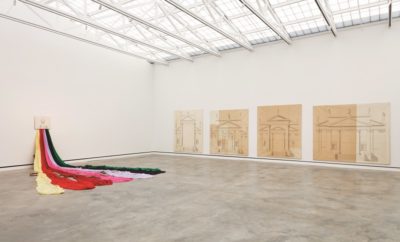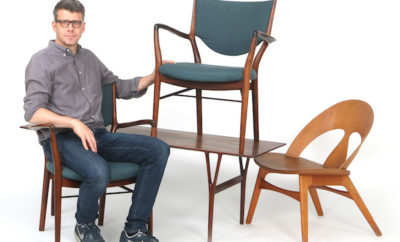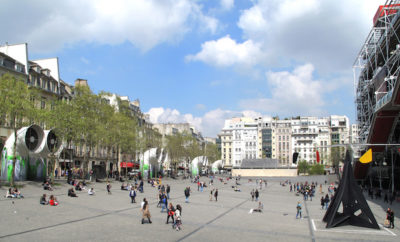 Kagan worked closely with Hirtenstein to develop the back-to-back custom sofa for his Amy Lau-designed apartment.
Kagan worked closely with Hirtenstein to develop the back-to-back custom sofa for his Amy Lau-designed apartment.
Feature
The Kagan Touch
Vladimir Kagan is hard at work. It is a breezy, bright day in Palm Beach, and though other octogenarians might be out on the shuffleboard court or lining up for the early-bird special, he is behind his desk (ocean view included) busily refining new designs, shooting off business e-mails, adding photos to his blog, vetting the images for a new catalogue, and much more. His assistant, the recent furniture design graduate Christopher Eitel, is in deep concentration at another computer, but when asked, jumps up to make mid-afternoon cappuccinos. Kagan pauses to give a bit of barista advice and then goes back to his analysis of a sofa he’s been designing, pausing to make a comment or two. “Multitasking is my way,” he says. “It’s my middle name. Call me Vladimir Multitask Kagan.” Though at eighty-seven he is walking more laboriously than he once did (and with the occasional aid of a scooter or walking poles), he is otherwise not slowing down. In this era of technology his work goes where he goes—which is Palm Beach for the winter, Nantucket for the summer, and New York in between.

Vladimir Kagan’s New York collection was shown in Milan at the Salone Internazionale del Mobile in 2008.
Thus, what otherwise would be a dining room table in the Palm Beach apartment has become a model shop for clay and balsa wood maquettes of chairs and sofas in two new lines of furniture. The new work is inspired by boat construction, which Kagan began to study in earnest last summer in a model-making class in Nantucket. “I can’t begin to tell you what gratification I get when I work with my hands,” he says. “The computer is so strong and willful. And in comparison, there’s clay…well, you mold it.”

The sculpted walnut nesting tables from 1950 date back to the early years in Kagan’s career.
Well into the sixth decade of his career, Kagan can watch as his earliest furniture commands high prices at auction and designers avidly seek his mid-century pieces for clients. He still runs his design business, Vladimir Kagan Inc., based in Clifton, New Jersey, and is producing limited edition lines for Ralph Pucci, his showroom dealer. He is also working with interior designers, significantly Amy Lau, to create custom pieces for the new residences of specific clients. “The most difficult thing for me,” he says, “is to reinvent myself in a way that’s creative and not repetitive. The challenge is to do work for the twenty-first century that expresses the time and yet is still ‘Kagan.’” This conundrum is compounded by the fact that even in a request for the unique object, “everyone really wants my 1950s pieces.”

Due to the complexity of the design, few examples of this Swan Neck floor lamp by Kagan, 1957, were produced.
To achieve all that, Kagan uses his own early work as a springboard, analyzing and modifying his classic designs to meet both general needs (to wit: the chairs are now bigger) and specific ones. Working with Lau on furniture for an apartment in lower Manhattan, he took off from the ideas of his early curved sofas to create a piece that offers back-to-back seating, which lets the apartment’s owner look out at his pool and the city beyond, then switch to the more conversational mode facing into the living room. “They’re Kagan,” he says, “but they’re also new.” This particular apartment also includes a revisited version of a chair Kagan designed in 1947 as well as dining chairs modified from a 1970s design to be more sculptural. “I think these are the most significant pieces I’ve done in years,” he says.

A recent display of Kagan’s work at the Ralph Pucci International showroom in Los Angeles was set against a groovy, mood-setting mural.
“He’s a master,” says Lau. “I feel like he’s in a zone. He’s creating these pieces with his hands and from the start to the finished product, the process is almost completely fluid. His work right now is extraordinary. He’s very experimental, and yet to me, it’s the best of all the periods of his career.”

This sofa designed in 1980 fetched $40,000 at Wright’s April 2012 “Living Contemporary” auction, off an estimate of $7,000 to $9,000.
Widowed two years ago (his wife of fifty-four years, Erica Wilson, was a renowned needlepoint designer), he now shares his longtime New York apartment with his daughter Vanessa Kagan Diserio and her family. (His elder daughter, Jessica Kagan Cushman, is a well-known jewelry designer and lives in Connecticut; his son, Illya, a painter, is year-round in Nantucket. In the summer, Vanessa runs her late mother’s needlepoint shop, also in Nantucket.) Kagan himself still races his sailboat—it’s an Indian, “which is twenty-two feet long and very wet,” he says. He also occasionally corrals fellow Model T enthusiasts for road trips in New England—but only the “flat” parts, he adds. The most recent of these adventures was a visit to the Battleship Cove museum in Fall River, Massachusetts.

Kagan’s boomerang table, designed in 1952, has hand-fitted mosaic tiles set in the curved walnut frame mounted on an iconic Kagan base.
Kagan was born in Worms, Germany, in 1927 and immigrated with his family to New York in 1938. After studying architecture at Columbia University, he joined his cabinetmaker father, Illi Kagan, and then in 1948 opened his first shop on East 65th Street in New York. Today his early designs are sought after at auction with interest ranging from healthy competition to unexpectedly high bids; at Wright’s May 2007 “Design Series” sale two of his 1967 Unicorn sofas sold for $96,000 and $90,000, respectively—more than triple the estimates.

Vladimir Kagan created one-of-a-kind furniture including the double-sided sofas for this Lower Manhattan apartment designed by Amy Lau for entrepreneur Michael Hirtenstein. Kagan also designed the chairs and coffee tables, taking some of his earlier pieces and adapting them into unique objects. Kagan working on a model of a sofa that will most likely be offered in a limited edition.
From the start, his furniture has reflected Kagan’s particular eye and artistic sensibilities—chairs, sofas, and tables with sensuous curves and daring geometries. It’s an aesthetic that has lingered through the years.
“It’s a vision,” says Lau. “It has an intellectual twist, or it’s lyrical, or sometimes, it’s the funniest thing you’ve ever seen. He has a vision, and it’s amazing to see him at work. He never stops. For him, it’s like breathing.”

This Kagan-designed 1953 sculpted cherry rocking chair and ottoman retains what is likely the original Boris Kroll upholstery.
Restlessly inquisitive, Kagan continues to explore new materials and forms. He created a group of sculptures for Ralph Pucci, and lately has been investigating (and using) fiberglass along with his more traditional wood and metal. He also created a rug design for the Artists’ Rugs of Sabine de Gunzburg now on view at Atelier Courbet in New York. A few years back he donated three drawings to the Glass House Project, a fundraiser for Philip Johnson’s Connecticut home, now a National Trust for Historic Preservation property. His publisher, Suzanne Slesin, calls his new work “transformative.”

The Lotus chair originally designed in 1970 has a Plexiglas shell with a floating upholstered seat.
His schedule, too, could put younger designers to a certain amount of shame. His Art Basel Miami Beach itinerary this past December featured visits to the design and art fairs, plenty of parties, a tour of Fairchild Tropical Botanic Garden, and attendance at the opening of Ralph Pucci’s new Miami showroom (“the space is gorgeous,” Kagan says.) Similarly, a three-day trip from Palm Beach to New York in February (almost all of it during a snowstorm) included a trip to the old mill that is now the Kagan factory in New Jersey, a visit to current clients on East End Avenue, and a long mentoring session with the now college-aged grandchildren of an early client. Not to mention separate meetings with Ralph Pucci and Suzanne Slesin. Slesin, who is the publisher and editorial director of Pointed Leaf Press, is releasing a second (revised and expanded, with a larger format) edition of Pointed Leaf’s sold-out The Complete Kagan in the fall. “Since 2004, Kagan’s international reach has grown by leaps and bounds, in showrooms in France and Italy, and with commissions for high-end interiors by some of the world’s leading architects and interior designers,” she notes.


Kagan designed the Unicorn sofa, model U522, in 1963. This pair, made for Selma Friedman, dates from 1967. Wright holds the top three records for the most expensive works ever sold by Vladimir Kagan—all are for Unicorn sofas auctioned in 2007. Each was estimated at $20,000 to $30,000, and they sold for $96,000, $90,000, and $66,000.
Back in Palm Beach, the sketchpads and pencils and modeling clays come out again. The two new lines he has under way are related to one another yet different: one is more artistic and sculptural and bound for a show at the Paris- and London-based Carpenters Workshop Gallery; the other, still adventurous but more furniture-like, is to go to Ralph Pucci. “He has a great eye and great taste,” says Kagan of Pucci. At his computer, he is uploading photos for his delightful, witty, informative blog—vladimirkagan.typepad.com. It is a comparatively new venture for Kagan, who had never spent much time putting words on paper. “I never wrote,” he says. “Now all of a sudden, I have an affinity for writing.”

Pair of walnut Contour lounge chairs, designed by Kagan in 1954.
Like paper and pen, wood and clay, even computer and mouse, the blog is yet one more form of expressing the ideas that fill his head nonstop. “But,” he says, “my real talent is making things look the way I envision them.”












